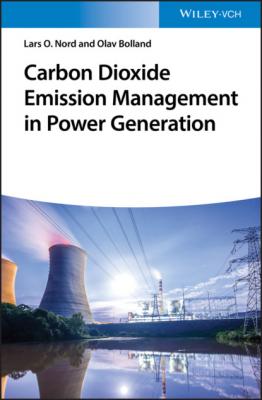Carbon Dioxide Emission Management in Power Generation. Prof. Lars O. Nord
Читать онлайн.| Название | Carbon Dioxide Emission Management in Power Generation |
|---|---|
| Автор произведения | Prof. Lars O. Nord |
| Жанр | Химия |
| Серия | |
| Издательство | Химия |
| Год выпуска | 0 |
| isbn | 9783527826650 |
The Norwegians, Erik Lindeberg and Torleif Holt, did a lot of work on CCS in the late 1980s and were the initiators of CCS in Norway. A significant contribution was made by Wim Turkenburg, Kornelius Blok, and Chris Hendriks in the Netherlands, who, among other things, organised the First International Conference on Carbon Dioxide Removal (ICCDR) in Amsterdam in March 1992. ICCDR and the Greenhouse Gas Mitigation Options Conference were merged in 1997 to form the Greenhouse Gas Control Technologies (GHGT) conference series, which is now established as the main conference within CCS.
During the 1980s, work related to CCS took place at Oak Ridge National Laboratory (ORNL) and the Electric Power Research Institute (EPRI) (Steinberg 1992). There was also activity related to CO2 capture at the Argonne National Laboratory from the early 1980s (Abraham et al. 1982).
It was not until close to 1990 that the volume of research effort in this field was increased to a significant level. The Japanese, and in particular, the RITE (Research Institute of Innovative Technology for the Earth), were already doing extensive work in the early 1990s. The main focus of research in Japan was on CO2 fixation and utilisation.
In 1991, the IEA Greenhouse Gas R&D Programme (IEA GHG) was established. IEA GHG is an Implementing Agreement of the International Energy Agency. In January 2013, the IEA GHG consisted of 19 member countries, the European Commission, OPEC, and 21 multinational industrial sponsors. The IEA GHG is playing a very important role as a coordinator for R&D activities within CCS. The Intergovernmental Panel on Climate Change (IPCC) has been important for the development of the interest in CCS and in justifying the need for CCS, by pointing to the necessity both to reduce greenhouse gas emissions and to emphasise CCS as a mitigation option.
It is important to note that many CO2 capture plants were built and operated with removal of CO2 from natural gas and synthesis gas during the 1970s and 1980s. CO2 was also captured from the flue gas in a number of plants that were built in this time period in order to provide CO2 for EOR (refer to Section 2.1.2) as well as for other industrialised use (Pauley 1983; Barchas and Davis 1992; Sander and Mariz 1992; Suda et al. 1992). One can say that the technology for the capture of CO2 from gas streams was already available at the time the idea of CCS emerged.
Notes
1 1 Absorption of electromagnetic radiation is the process by which the energy of a photon is taken up by an atom. The photon is destroyed in the process. The term ‘absorption’ is also used within chemical engineering as uptake of a gas in a liquid or solid material, as described in Section 9.1. The term is also used in a number of other areas.
2 2 Aerosol refers here to liquid droplets or solid particles in the atmosphere, such as sulfate aerosols from fossil fuel combustion or particles from volcano eruptions.
3 3 Peak oil is the point in time at which the maximum global oil production rate is reached, after which the rate of production starts to decline. Marion King Hubbert (1903–1989) first used the theory in 1956 to predict that US oil production would peak between 1965 and 1970. His model, the Hubbert peak theory, has since been used by some to predict the peak oil production globally.
4 4 Sequestration is mainly used in North America. The term has different meanings in English, French, and Spanish and is also for many people a difficult word to relate to. Most people within the scientific community, including IPCC, have adopted ‘capture and storage’ IPCC-CCS (2005 ). IPCC Special Report on Carbon Dioxide Capture and Storage. Cambridge, United Kingdom, and New York, NY, USA, Cambridge University Press.
5 5 Partial pressure relates to a specific gas in a gas mixture and the pressure that the gas would have if it alone occupied the volume (assuming ideal gas). According to Dalton's law, the sum of the partial pressure for the all the gases in a gas mixture equals the total pressure. Partial pressure equals the molar (or volumetric) fraction multiplied by the total pressure.
Конец ознакомительного фрагмента.
Текст предоставлен ООО «ЛитРес».
Прочитайте эту книгу целиком, купив полную легальную версию на ЛитРес.
Безопасно оплатить книгу можно банковской картой Visa, MasterCard, Maestro, со счета мобильного телефона, с платежного терминала, в салоне МТС или Связной, через PayPal, WebMoney, Яндекс.Деньги, QIWI Кошелек, бонусными картами или другим удобным Вам способом.
